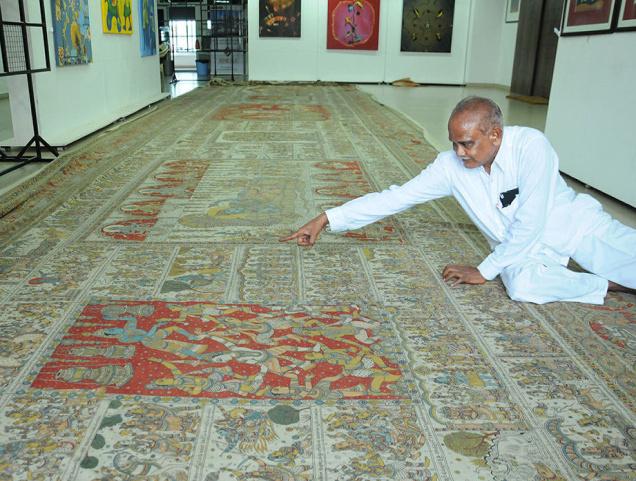
A.P. Kalamkari artist comes up with a 47×11-ft record piece for posterity
He was not aiming for a record; his eyes were set much higher. “Creating the record was a by-product. I had started out with the idea of doing something that will help me pass on this treasure of art to the next generation,” says K. Siva Prasad Reddy, a master craftsman of Kalamkari art from Tanguturu village of Banaganapalle mandal in Kurnool district.
Pointing to his 47×11-ft Kalamkari art piece, completed in 2002, which is a pictorial depiction of more than 2,000 images from Ramayana, Mahabharata and Bhagwad Geeta, he declares with a glint of pride in his eyes:
“This is the longest Kalamkari art produced so far.” Mr. Reddy is the recipient of several awards that include one from the UNESCO, the President’s award and the State award and many other laurels.
Today, the 60-year-old man is a contented soul. “I was desperately seeking a means to preserve this art for posterity. It took me two years to finish this. While I was working on it, I was hit hard by financial crisis as I had no other income. My children’s education was at stake but I was determined not to stop half-way. I sold my three-acre farm land to support the family during the two years. The decision was hard then but today, I am happy having done what I did,” he says emphatically.
Mr. Reddy comes from an agriculture background but he was a reluctant farmer. “A newspaper ad on free training in Kalamkari art was reason enough for me to leave farming and join the training programme. I soon realised that this was my calling,” he says.
Despite the hard work involved in Kalamkari, finding marketing avenues was very difficult. “Fortunately, fashion designers came to our rescue. Once they embraced this eco-friendly fabric, people from elite sections started buying it,” he recalls, pointing out that the fabric is now used in home furnishings, apparel and accessories.
“Foreigners outnumber Indian buyers as they like the fact that the dyes used in the cloth are obtained by extracting colours from parts of fruits, vegetables, roots and leaves with mineral salts of iron, tin, copper and other metals serving as mordants (that helps bind the colour to the fabric).
‘Growing awareness’
“The growing awareness among people on the harmful effects of dangerous chemical dyes has come as a boon to us. They have started developing a taste for naturally dyed fabrics and what more, Kalamkari is the best specimen of natural colour artwork,” he says.
The duplicate version of Kalamkari fabric flooding the markets worries Mr. Reddy. “These fake designs are ruining the Kalamkari industry. But then, it also makes me feel happy that only products that are in great demand in market spawn replicas,” he adds with a smile.
source: http://www.thehindu.com / The Hindu / Home> News> Cities> Vijayawada / by P. Sujatha Varma / Vijayawada – April 19th, 2016